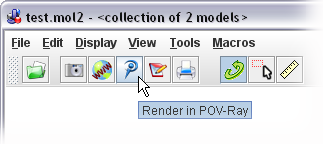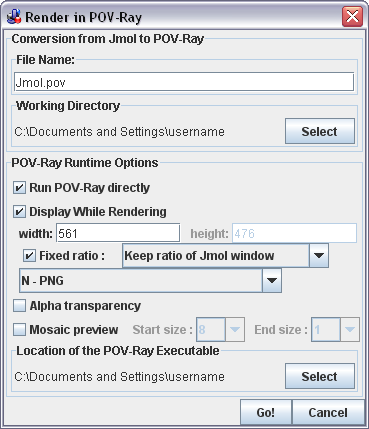Difference between revisions of "File formats/Ray Tracing"
m |
|||
| Line 24: | Line 24: | ||
| − | The 3.7 Unofficial release appears to utilise 2 cores fully. It runs the model.pov and model.pov.ini files generated by Jmol 13.0.18 and produces fine images. | + | The MegaPOV 3.7 Unofficial release appears to utilise 2 cores fully. It runs the model.pov and model.pov.ini files generated by Jmol 13.0.18 and produces fine images. |
The technique which has worked for me on 10.6.8 is: | The technique which has worked for me on 10.6.8 is: | ||
| Line 38: | Line 38: | ||
Some examples are at http://ptmgallery.s3.amazonaws.com/list.html | Some examples are at http://ptmgallery.s3.amazonaws.com/list.html | ||
| − | + | Using 2 cores (see the Render Pefererences panel, Bounding and Threads) only drops the render time from say 5 seconds to 4 seconds for a small molecule (amino acid) and not much different for a larger one (eg. 1GFL.pdb). You can see the two threads at times, when one falls behind the other on a time-consuming piece of the scene, and the checkerboard updates separately. | |
| − | + | There appears to be no command-line version of (Mega)POV-Ray Unofficial 3.7. Ie. running the app always launches into the full Gui version. | |
| − | The Unix/Linux version can | + | The Unix/Linux version of POV-Ray can run on Mac as well, and has command-line abilities. Useful discussion is at: |
http://news.povray.org/povray.unix/ and | http://news.povray.org/povray.unix/ and | ||
| − | http://news.povray.org/povray.macintosh/ I have not put time into this | + | http://news.povray.org/povray.macintosh/ It would need to be built from source, which can vary greatly in difficulty depending mainly on how far the libraries needed have changed from the set used at the time (2007/8/9) . I have not put time into this. |
===POV-Ray for Windows=== | ===POV-Ray for Windows=== | ||
| Line 50: | Line 50: | ||
An update for POV-Ray on Windows, Oct 2013. The following was tested on Windows 7, under Parallels 7 on Mac OS X 10.6.8. | An update for POV-Ray on Windows, Oct 2013. The following was tested on Windows 7, under Parallels 7 on Mac OS X 10.6.8. | ||
| − | The standard latest POV-Ray Windows release is 3.6. Can be downloaded from http://www.povray.org/download/#binaries . I used the 32 bit version | + | The standard latest POV-Ray Windows release is 3.6.2. Can be downloaded from http://www.povray.org/download/#binaries . I used the 32 bit version. |
Install POV-Ray 3.6 wherever you prefer, then run Jmol as a standalone app (by clicking in Windows Explorer, or java -jar Jmol.jar mymodel.pdb). The POV-Ray icon on the menubar will bring up the dialog shown below. Fill in the location of the POV-Ray executable (pvengine.exe). | Install POV-Ray 3.6 wherever you prefer, then run Jmol as a standalone app (by clicking in Windows Explorer, or java -jar Jmol.jar mymodel.pdb). The POV-Ray icon on the menubar will bring up the dialog shown below. Fill in the location of the POV-Ray executable (pvengine.exe). | ||
| Line 56: | Line 56: | ||
Hit Go. A dialog may pop up asking for special permission to read the Jmol.pov file, answer yes. (This is a POV-Ray security check, read the Help in the dialog for details). The molecule will then render. | Hit Go. A dialog may pop up asking for special permission to read the Jmol.pov file, answer yes. (This is a POV-Ray security check, read the Help in the dialog for details). The molecule will then render. | ||
| − | POV-Ray 3.7 and MegaPOV | + | POV-Ray 3.7 Beta adds SMP facilities. It worked fine and reduced render times by about 20%. I used the 32-bit version. |
| + | |||
| + | MegaPOV 1.2.1 for Windows appears to require POV-Ray 3.6 to be already installed, and expects some init files in precise default locations, and probably other assumptions. I did not pursue this further. | ||
Latest revision as of 23:58, 29 October 2013
Contents
File Formats for Ray Tracing Images Exported from Jmol
Recent versions of Jmol application and signed applet can export models to several high-quality image formats that can be displayed and edited in ray tracing programs like POV-Ray and Tachyon.
POV-Ray
Jmol can export, with limited features, the current view of a model into POV-Ray format. This can be done from script or from the pop-up menu, but is better controled using the top menu in the Jmol application, which opens a dialog with options.
Please, note that two files will be written: the main file and an additional one with a .ini extension appended (a typical example would be ![]() xxx.pov and
xxx.pov and ![]() xxx.pov.ini).
xxx.pov.ini).
- Home page for POV-Ray, the Persistence of Vision Raytracer.
- Information on POV-Ray on Wikipedia.
- Home page for MegaPOV, an extension of POV-Ray.
POV-Ray for Mac
The following updates POV-Ray for Mac, as of Oct 2013. The latest official release for Mac from POV-Ray is 3.6, dating from somewhere around 2007. It runs only on Power PC Macs, not on Intel Macs, ie. it is not a Mac OS X Universal Binary (containing IBM Power-PC and Intel binaries).
For Windows, POV-Ray Release 3.7 is available, the main addition being SMP abilities, ie. it can run on all cores of a chip - useful for a ray-tracer which is an "embarrassingly parallel" type of code. This appears to date from about 2009.
Prior to OS X 10.6 (Snow Leopard) Macs used the Rosetta emulator to run Power-PC apps on the later Intel chips. However this is defaulted off in 10.6. It can be installed, see http://support.apple.com/kb/ph6531 . However I believe that it is somewhat problematic at 10.6 or later.
However MegaPOV which is a much more active POV-Ray extension has released a "3.7 Unofficial" release for Mac in 2013. Available at http://megapov.inetart.net/povrayunofficial_mac/index.html This runs ok on Mac OS X 10.6.8 (Snow Leopard) and allegedly later, ie. 10.7 Lion and 10.8 Mountain Lion. If you search for "povray 3.7 unofficial mac" you will find the announcements and some discussion.
The MegaPOV 3.7 Unofficial release appears to utilise 2 cores fully. It runs the model.pov and model.pov.ini files generated by Jmol 13.0.18 and produces fine images.
The technique which has worked for me on 10.6.8 is:
- Adjust Jmol window size to 800x600
- Get your Jmol scene how you want it.
- Use the Jmol Console to save a scene with "write POVRAY scene.pov" .. this produces scene.pov and scene.pov.ini
- In POV-Ray Unofficial3.7, in Control Panel / Files & Paths, specify scene as your scene.pov, image as scene.png (*)
- Also in that panel, Tick 'Use Ini File', and specify scene.pov.ini
- Also in that panel, if any standard POV-ray include files are needed, specify <path>/POV-Ray 3.7Unofficial/include as a search path for includes.
- In the panel Image & Quality, select 800x600. (This laborious matching of 800x600 is not fully necessary but it will get you going. Later you can play with sizes and aspect ratios).
- In Misc, you can also set a path for all output images, which overrides setting (*) above.
Some examples are at http://ptmgallery.s3.amazonaws.com/list.html
Using 2 cores (see the Render Pefererences panel, Bounding and Threads) only drops the render time from say 5 seconds to 4 seconds for a small molecule (amino acid) and not much different for a larger one (eg. 1GFL.pdb). You can see the two threads at times, when one falls behind the other on a time-consuming piece of the scene, and the checkerboard updates separately.
There appears to be no command-line version of (Mega)POV-Ray Unofficial 3.7. Ie. running the app always launches into the full Gui version.
The Unix/Linux version of POV-Ray can run on Mac as well, and has command-line abilities. Useful discussion is at: http://news.povray.org/povray.unix/ and http://news.povray.org/povray.macintosh/ It would need to be built from source, which can vary greatly in difficulty depending mainly on how far the libraries needed have changed from the set used at the time (2007/8/9) . I have not put time into this.
POV-Ray for Windows
An update for POV-Ray on Windows, Oct 2013. The following was tested on Windows 7, under Parallels 7 on Mac OS X 10.6.8.
The standard latest POV-Ray Windows release is 3.6.2. Can be downloaded from http://www.povray.org/download/#binaries . I used the 32 bit version.
Install POV-Ray 3.6 wherever you prefer, then run Jmol as a standalone app (by clicking in Windows Explorer, or java -jar Jmol.jar mymodel.pdb). The POV-Ray icon on the menubar will bring up the dialog shown below. Fill in the location of the POV-Ray executable (pvengine.exe).
Hit Go. A dialog may pop up asking for special permission to read the Jmol.pov file, answer yes. (This is a POV-Ray security check, read the Help in the dialog for details). The molecule will then render.
POV-Ray 3.7 Beta adds SMP facilities. It worked fine and reduced render times by about 20%. I used the 32-bit version.
MegaPOV 1.2.1 for Windows appears to require POV-Ray 3.6 to be already installed, and expects some init files in precise default locations, and probably other assumptions. I did not pursue this further.
Saving from Jmol application
The application's top menu bar has
File > Export > Render in POV-Ray
which produces images that can be displayed and edited in this ray tracing program (using a dialog with options).
There is also a button in the toolbar that invokes the same dialog.

Saving from Jmol application and signed applet
The pop-up menu also allows in these cases (not in the normal, unsigned applet) to save a snapshot of the model in POV-Ray format. Open the pop-up menu (right-click, or Ctrl+click, or click on Jmol frank) and choose File > Save (or directly Save in older versions). After choosing a format, a dialog will open to choose the location and filename.
In this method, no other options for the export will be offered.
You can also export using a script (e.g. from the console) with the write command (see the scripting documentation).
Tachyon
Jmol can export, with limited features, the current view of a model into Tachyon format. Currently this can only be done from script.
- Home page for Tachyon, a Parallel / Multiprocessor Ray Tracing System.
- File format specification.
